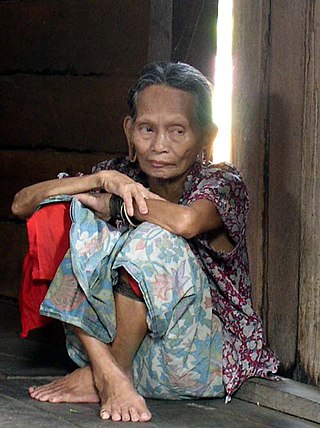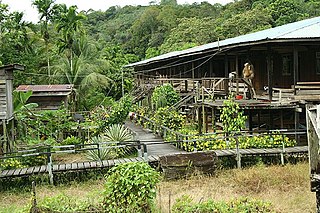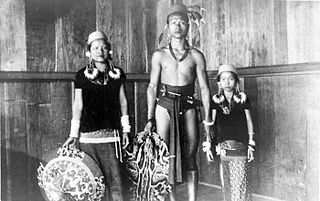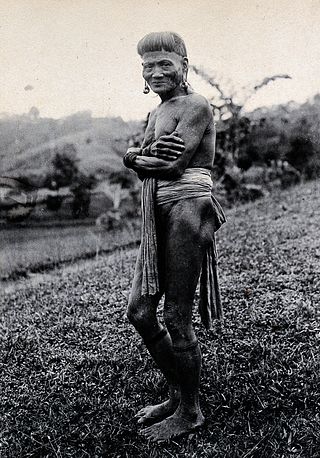
Being an indigenous tribe in Borneo, the Kayan people are similar to their neighbours, the Kenyah tribe, with which they are grouped together with the Bahau people under the Apo Kayan people group. The Kayan people are categorised as a part of the Dayak people. They are distinct from, and not to be confused with, the Kayan people of Myanmar.

The Penan are a nomadic indigenous people living in Sarawak and Brunei, although there is only one small community in Brunei; among those in Brunei half have been converted to Islam, even if only superficially. Penan are one of the last such peoples remaining as hunters and gatherers. The Penan are noted for their practice of 'molong' which means never taking more than necessary. Most Penan were nomadic hunter-gatherers until the post-World War II missionaries settled many of the Penan, mainly in the Ulu-Baram district but also in the Limbang district. They eat plants, which are also used as medicines, and animals and use the hides, skin, fur, and other parts for clothing and shelter.

The Rajang River is a river in Sarawak, northwestern Borneo, Malaysia. The river originates in the Iran Mountains, flows through Kapit, and then towards the South China Sea. At approximately 565 km long (351 mi), the river is the seventh-longest in Borneo and the longest in Malaysia.

The White Rajahs were a dynastic monarchy of the British Brooke family, who founded and ruled the Raj of Sarawak, located on the north west coast of the island of Borneo, from 1841 to 1946. The first ruler was Briton James Brooke. As a reward for helping the Sultanate of Brunei fight piracy and insurgency among the indigenous peoples, he was granted the province of Kuching, which was known as Sarawak Asal in 1841 and received independent kingdom status.

Belaga is a district in Kapit Division, Sarawak, Malaysia. It is located on the upper reaches of the Rajang River, some 120 kilometers northeast of Kapit and slightly less than 100 kilometers from the South China Sea coast near Bintulu. It is located within the Hulu Rajang parliamentary constituency.

Tatau is a town, and the capital of the Tatau District in Bintulu Division, Sarawak, Malaysia. The district's reported total population for Tatau was 30,383. Tatau became a district in 1987. Before that it was a Sub District under Bintulu District. The main spoken languages are Iban, Kenyah, Beketan and Punan.

Orang Ulu is an ethnic designation politically coined to group together roughly 27 very small but ethnically diverse tribal groups in northeastern Sarawak, Malaysia with populations ranging from less than 300 persons to over 25,000 persons. Orang Ulu is not a legal term, and no such racial group exists or is listed in the Malaysian Constitution. The term was popularised by the Orang Ulu National Association (OUNA), which was formed in 1969. Orang Ulu is totaling 180 000 people which is 6.2% from 2.8millions of Sarawak people.

Punan Sama is a small village (longhouse) situated along the Rajang River in Sarawak, Malaysia. The longhouse's previous name was "Lovuk Tepeleang". The majority of those inhabiting the longhouse are Punan, with a few Sekapan, Kejaman and Lahanan, as a result of inter marriage.

Melanau or A-Likou is an ethnic group indigenous to Sarawak, Malaysia. They are among the earliest settlers of Sarawak. They speak in the Melanau language, which is a part of the North Bornean branch of Malayo-Polynesian languages.

The Kenyah people are an indigenous, Austronesian-speaking people of Borneo, living in interior North and East Kalimantan, Indonesia and Sarawak, Malaysia.

The Ukit people are a tribe found in Sarawak, Malaysia. They are a small minority people who until recently were nomads in the rain forests of Borneo. Some were settled at Rumah Ukit on the upper reaches of the Batang Balui or Balui River. Most of the Ukits are found in the Upper Rajom and Tatau rivers, Baleh, Sarawak. The Ukit people were also regarded as a sub-group of the purported Klemantan people.
The Kayanic or Kayan–Murik languages are a group of Austronesian languages spoken in Borneo by the Kayan, Morek Baram, Bahau, and related peoples.
The Melanau–Kajang languages or Central Sarawak languages are a group of languages spoken in Kalimantan, Indonesia and Sarawak, Malaysia by the Kenyah, Melanau and related peoples.
The Punan languages or Rejang-Sajau languages are a group of mutually intelligible isolects spoken by the Punan and related peoples of Borneo in Indonesia and Malaysia.

Tatau District is one of the two districts of Bintulu Division in Sarawak, Malaysia. It has a total area of 4,945.80 square kilometres. The largest town in the district is Tatau.

Sebauh is a district of Bintulu Division, Sarawak, Malaysia. It shares a boundary with Miri, Baram, Kapit Division, Belaga and Tatau. It has a total area of roughly 5,262.90 square kilometres. Sebauh town is a main administrative and economy centre of Sebauh district.

The Bintulu District is one of two districts of Bintulu Division in Sarawak, Malaysia. It has a total area of 7,220.40 square kilometres. Bintulu District has a sub-district, which is Sebauh. There are two towns in Bintulu District, namely Bintulu, which is the capital of both Bintulu District and Bintulu Division, and Sebauh.
Sarawak's population is very diverse, comprising many races and ethnic groups. Sarawak has more than 40 sub-ethnic groups, each with its own distinct language, culture and lifestyle. This makes Sarawak demography very distinct and unique compared to its Peninsular counterpart. However, it largely mirrors to other territories in Borneo - Sabah, Brunei and Kalimantan.

Bahau people is a sub-ethnic group of the Dayak people who inhabit West Kutai Regency (9.3%), East Kalimantan, Indonesia.

Bukit Mabong is a district, in Kapit Division, Sarawak, Malaysia.



















